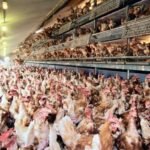A growing number of consumers are wanting to become more educated and involved when it comes to the food they consume, where it comes from and how it’s raised, grown and treated. If you’re reading this, chances are, you’re one of these people.
Pasture raised, free range, cage free, and variations of these terms can be somewhat confusing and well, at times, misleading.
 Caged – This is how the large majority of eggs for human consumption are produced in the US. It’s efficient, easily controlled, and very profitable. Farms are able to cram thousands, and sometimes tens of thousands, of chickens into a single barn. Each chicken lives out its productive life in a cage, usually less than 1 square foot, and fed a diet of corn/soy. Everything is automated, feed, lighting, even eggs roll out and down a conveyor for processing and packing. After their usefulness is used up, and their egg production begins to slow, they’re disposed of, or shipped off to be processed into everything from pet food to chicken soup. You’ll typically find eggs produced this way in grocery stores and supermarkets. Rarely, if ever, would you find anyone selling eggs at a Farmers Market, that were produced in this manner, unless they were repackaging eggs as their own. If you can’t find any terms printed on the carton describing how the chicken was raised, chances are, the eggs produced from chickens that were raised in this type of environment. Caged – This is how the large majority of eggs for human consumption are produced in the US. It’s efficient, easily controlled, and very profitable. Farms are able to cram thousands, and sometimes tens of thousands, of chickens into a single barn. Each chicken lives out its productive life in a cage, usually less than 1 square foot, and fed a diet of corn/soy. Everything is automated, feed, lighting, even eggs roll out and down a conveyor for processing and packing. After their usefulness is used up, and their egg production begins to slow, they’re disposed of, or shipped off to be processed into everything from pet food to chicken soup. You’ll typically find eggs produced this way in grocery stores and supermarkets. Rarely, if ever, would you find anyone selling eggs at a Farmers Market, that were produced in this manner, unless they were repackaging eggs as their own. If you can’t find any terms printed on the carton describing how the chicken was raised, chances are, the eggs produced from chickens that were raised in this type of environment. |
 Cage-Free – Same living conditions as the caged chickens, just without the cages. They’re still crammed inside that same barn, just not in cages. They do have a little more room, around 1 square foot per bird, and still fed a diet that’s usually comprised of corn/soy. Cage-Free – Same living conditions as the caged chickens, just without the cages. They’re still crammed inside that same barn, just not in cages. They do have a little more room, around 1 square foot per bird, and still fed a diet that’s usually comprised of corn/soy. |
 Free-Range – Imagine the same barn, not quite as many birds, because now they each get about 2 square feet per bird. They still spend the majority of their time indoors, but are allowed time outside, usually in a fenced in area. Still fed the same diet of corn/soy. Free-Range – Imagine the same barn, not quite as many birds, because now they each get about 2 square feet per bird. They still spend the majority of their time indoors, but are allowed time outside, usually in a fenced in area. Still fed the same diet of corn/soy. |
 Pasture Raised – If you’re at all concerned about the living condition of the chickens that lay the eggs or produce the meat you consume, this is what you’re looking for. This term isn’t defined or regulated by the USDA, so farms that use this term can vary. What this means on our farm is that each of our hens has: Pasture Raised – If you’re at all concerned about the living condition of the chickens that lay the eggs or produce the meat you consume, this is what you’re looking for. This term isn’t defined or regulated by the USDA, so farms that use this term can vary. What this means on our farm is that each of our hens has: |
If you’re looking for a humanely produced, best tasting egg possible, this is what you’re looking for! |
https://www.huffingtonpost.com/entry/defining-egg-labels_us_57ffaabfe4b05eff55820176